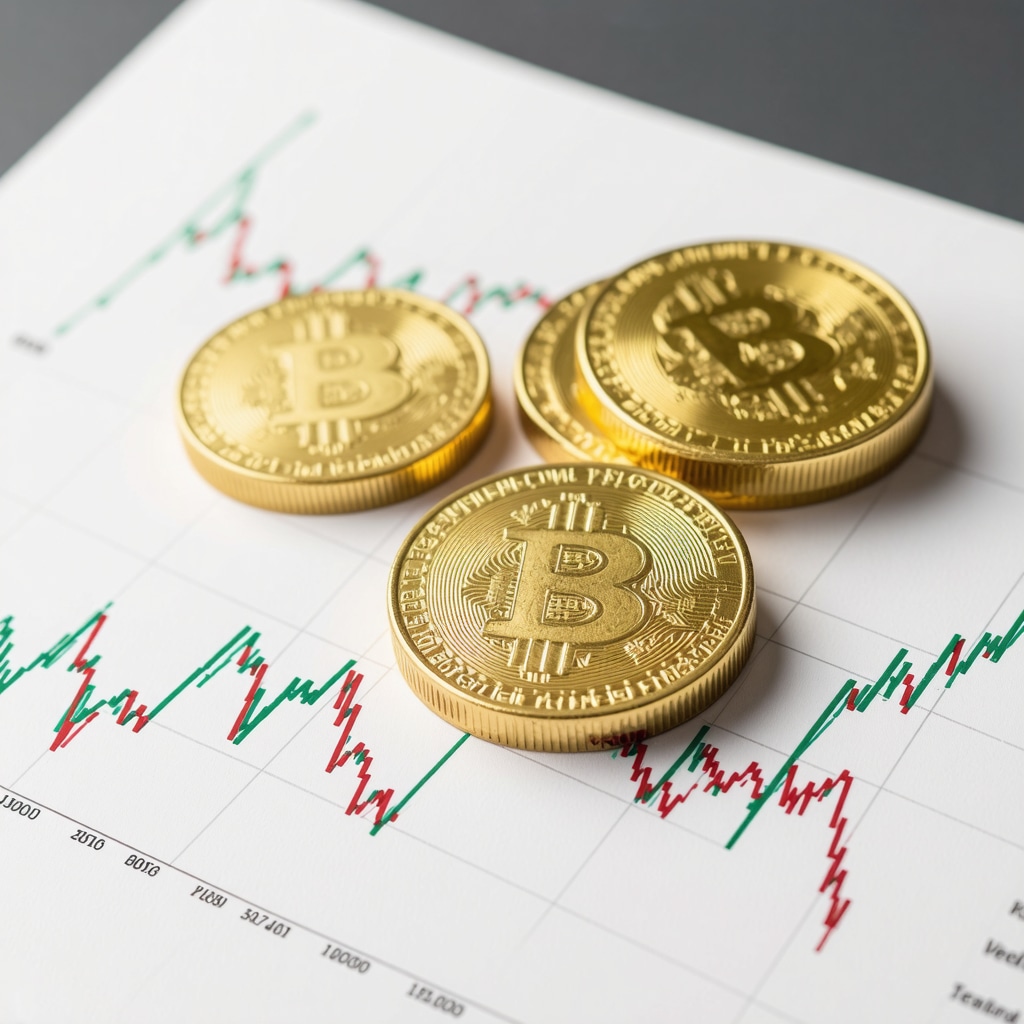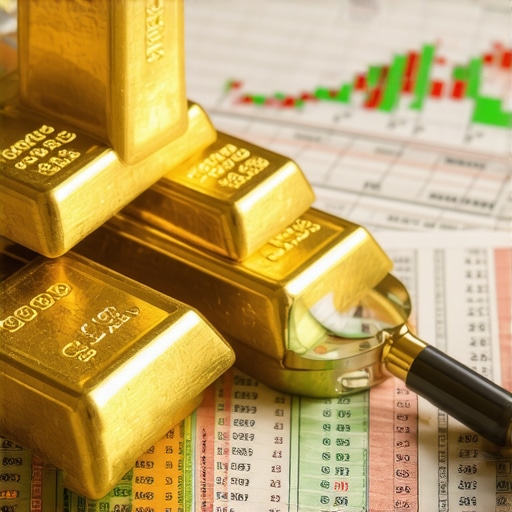Why Gold Coins Remain a Timeless Inflation Hedge in 2025
In an era marked by economic uncertainty and fluctuating inflation rates, savvy investors are turning to tangible assets to protect their wealth. Among these, gold coins stand out as a particularly effective hedge against inflation. Unlike paper assets, gold possesses intrinsic value, historically preserving purchasing power during times of currency devaluation. This enduring appeal makes understanding the best gold coins to buy in 2025 essential for anyone aiming to safeguard their portfolio.
Unveiling the Top Gold Coins: A Curated Selection for Inflation Protection
Not all gold coins deliver equal value or liquidity. Selecting the right coins involves balancing purity, recognition, and market demand. Among the elite choices are the American Gold Eagle, renowned for its 22-karat alloy durability and legal tender status; the Canadian Gold Maple Leaf, prized for its 99.99% purity and exquisite minting quality; and the South African Krugerrand, a pioneer in bullion coinage with widespread global recognition. Each offers unique advantages for investors seeking a reliable inflation hedge.
How Do These Gold Coins Compare in Terms of Investment Security and Liquidity?
Investment security in gold coins hinges on authenticity and market acceptance. Coins like the American Gold Eagle and Canadian Gold Maple Leaf boast robust anti-counterfeiting features and are backed by their respective governments, enhancing trust. Liquidity is equally critical; these coins are widely traded internationally, enabling investors to convert them to cash swiftly if needed. In contrast, less recognized coins might pose challenges in resale and valuation, underscoring the importance of choosing well-established bullion coins.
Expert Strategies: Maximizing Your Gold Coin Investment in 2025
To capitalize on gold coins as an inflation hedge, diversification within the bullion coin segment is recommended. Combining different coins can mitigate country-specific risks and fluctuations in premiums. Additionally, purchasing from reputable dealers is paramount to avoid counterfeit pitfalls. Utilizing secure storage solutions, such as insured vaults or professional custodians, further protects physical assets. Investors may also consider complementing physical gold holdings with gold ETFs or mutual funds for portfolio flexibility, as detailed in our guide on choosing between bullion and ETFs.
What Makes Physical Gold Coins a More Tangible Hedge Compared to Digital Gold Investments?
While digital gold investments like ETFs offer ease of access and liquidity, physical gold coins provide direct ownership and immunity from counterparty risks. They serve as a physical store of value that cannot be devalued by financial system failures or electronic glitches. This tangibility is particularly reassuring during hyperinflation or severe economic disruptions. Nevertheless, investors must weigh storage and insurance considerations against the convenience of digital options.
Ready to Secure Your Wealth? Share Your Thoughts or Experiences with Gold Coin Investments Below!
For a deeper dive into effective gold investment strategies and market insights, explore our comprehensive analysis at Top Gold Investment Strategies to Hedge Against Inflation 2025. Additionally, the World Gold Council provides authoritative, data-driven perspectives on gold’s role in financial portfolios, accessible at Gold Investment Outlook.
Personal Reflections on Choosing the Right Gold Coins for My Portfolio
When I first started investing in gold coins, I was overwhelmed by the variety and the technical details. It wasn’t just about picking a shiny coin; it was about understanding market demand, historical performance, and even geopolitical factors that affect gold prices. For instance, I remember hesitating between the Canadian Gold Maple Leaf and the South African Krugerrand. The Maple Leaf’s purity fascinated me, but the Krugerrand’s legacy and global acceptance made me appreciate its liquidity benefits. Over time, I learned to balance these factors based on my risk tolerance and investment goals, which has been invaluable during the recent inflationary spikes.
Storage Realities: Why Secure Handling of Physical Gold Matters More Than Ever
One of the lessons I’ve learned the hard way is the importance of secure storage. Physical gold coins, while tangible and reassuring, come with the responsibility of safekeeping. I opted for a professional vault service after hearing stories about home safes being compromised or gold misplaced during moves. This choice gave me peace of mind and also allowed me to focus on market opportunities without worrying about physical risks. If you’re considering this route, it’s worth exploring expert tips on how to store physical gold safely to protect your investment effectively.
How Can Investors Balance Physical Gold and Digital Gold for Optimal Security and Flexibility?
This question has come up repeatedly in my conversations with fellow investors. Physical gold offers undeniable security and psychological comfort; however, its liquidity and transaction costs can sometimes be limiting. On the other hand, digital gold investments such as gold ETFs provide ease of trading, diversification, and lower entry costs. In my experience, a blended strategy works best. Allocating a portion of your portfolio to physical coins ensures you hold a real, inflation-resistant asset, while ETFs and mutual funds add flexibility and exposure to broader gold market dynamics. For a detailed comparison, I highly recommend checking out our guide on comparing gold ETFs and mutual funds.
Learning from Market Trends: The Impact of Global Demand Shifts on Gold Prices
Tracking gold demand trends has become part of my routine to anticipate price movements. For example, increased gold purchasing by central banks or surging demand in jewelry markets can signal bullish momentum. The World Gold Council’s research, which I often consult, highlights how geopolitical tensions and economic policies influence these trends. It’s fascinating how these factors converge to affect the value of the coins I hold. Staying informed helps me make timely decisions rather than reacting impulsively during market volatility.
What’s Your Experience with Balancing Physical and Digital Gold Investments in Today’s Market?
Have you found a strategy that blends the tangible security of coins with the convenience of digital assets? I’d love to hear your stories or challenges in the comments below. Sharing these insights helps build a community of informed investors ready to navigate the complexities of gold investing. And if you want to broaden your understanding, explore more on using gold as a hedge against economic uncertainty.
Decoding Premiums and Market Timing: Advanced Insights for Gold Coin Investors
Understanding the nuances of gold coin premiums is crucial for sophisticated investors aiming to optimize returns. Premiums—the amount above the spot gold price paid to acquire coins—depend on factors such as coin rarity, condition, demand, and dealer markup. For instance, limited-mintage coins or those with historical significance often command higher premiums but may also offer unique appreciation potential beyond bullion value. Conversely, widely recognized bullion coins typically trade with lower premiums, ensuring easier liquidity.
Timing purchases during market dips or geopolitical uncertainty can significantly affect acquisition costs. Seasonality also plays a role; demand spikes around cultural festivities or investment cycles can inflate premiums. Staying alert to these cycles, combined with a keen eye on macroeconomic indicators, equips investors to strategically enter or exit positions, enhancing portfolio resilience against inflation shocks.
How Can Investors Effectively Assess and Mitigate Risks Associated with Gold Coin Premium Volatility?
Premium volatility stems from shifts in supply-demand imbalances, dealer competition, and macroeconomic factors like interest rates or currency fluctuations. To mitigate these risks, investors should diversify across coin types and sources, avoid overpaying during hype periods, and maintain relationships with multiple reputable dealers for competitive pricing. Employing real-time market data analytics and subscribing to specialized bullion market reports can also provide early warnings of premium inflation or compression, enabling proactive decision-making.
Global Political and Economic Undercurrents: Their Influence on Gold Coin Valuations
Gold’s role as a safe haven asset becomes especially prominent during geopolitical turmoil or economic instability. Recent research by the World Gold Council underscores how escalating tensions, trade disputes, and central bank policies dynamically influence gold demand and pricing.1 For example, increased central bank gold purchases in emerging economies signal confidence in gold as a reserve asset, pushing prices—and consequently coin valuations—higher.
Meanwhile, currency devaluations or inflationary pressures in key markets can create arbitrage opportunities for investors adept at cross-border coin acquisitions. However, regulatory changes affecting import/export or taxation of precious metals remain a persistent risk factor requiring vigilant monitoring.
Leveraging Technological Innovations: Blockchain and Authentication in Gold Coin Trading
Emerging technologies are reshaping gold coin investment, particularly in authentication and provenance tracking. Blockchain-based certification offers immutable records of coin origin, ownership history, and authenticity, drastically reducing counterfeiting risks.2 This transparency not only enhances investor confidence but can also streamline secondary market transactions by providing verifiable, tamper-proof data.
Additionally, digital platforms integrating smart contracts facilitate fractional ownership, broadening access to high-value coins previously out of reach for many investors. These innovations promise to bridge the gap between physical asset tangibility and digital liquidity, creating hybrid investment models that combine the best of both worlds.
Exploring the Intersection of Tradition and Innovation: What Are the Challenges and Opportunities of Blockchain-Enabled Gold Coin Investments?
While blockchain offers compelling benefits, challenges include technological adoption barriers among traditional dealers, regulatory uncertainties, and the need for standardized protocols. Early adopters who navigate these complexities can gain competitive advantages through enhanced transparency, reduced fraud, and expanded market access. Investors interested in these cutting-edge developments should follow updates from industry consortia such as the World Gold Council’s blockchain initiatives.
Call to Action: Deepen Your Mastery of Gold Investment Strategies
To harness these advanced insights and emerging trends effectively, continuous education and engagement with expert analysis are indispensable. I invite you to explore our specialized resources and participate in our investor forums where complex strategies, market signals, and innovative technologies are dissected in detail. Your journey toward mastering gold coin investments in 2025 and beyond begins with staying informed and connected.
Decoding Premiums and Market Timing: Advanced Insights for Gold Coin Investors
Understanding the nuances of gold coin premiums is crucial for sophisticated investors aiming to optimize returns. Premiums—the amount above the spot gold price paid to acquire coins—depend on factors such as coin rarity, condition, demand, and dealer markup. For instance, limited-mintage coins or those with historical significance often command higher premiums but may also offer unique appreciation potential beyond bullion value. Conversely, widely recognized bullion coins typically trade with lower premiums, ensuring easier liquidity.
Timing purchases during market dips or geopolitical uncertainty can significantly affect acquisition costs. Seasonality also plays a role; demand spikes around cultural festivities or investment cycles can inflate premiums. Staying alert to these cycles, combined with a keen eye on macroeconomic indicators, equips investors to strategically enter or exit positions, enhancing portfolio resilience against inflation shocks.
How Can Investors Effectively Assess and Mitigate Risks Associated with Gold Coin Premium Volatility?
Premium volatility stems from shifts in supply-demand imbalances, dealer competition, and macroeconomic factors like interest rates or currency fluctuations. To mitigate these risks, investors should diversify across coin types and sources, avoid overpaying during hype periods, and maintain relationships with multiple reputable dealers for competitive pricing. Employing real-time market data analytics and subscribing to specialized bullion market reports can also provide early warnings of premium inflation or compression, enabling proactive decision-making.
Global Political and Economic Undercurrents: Their Influence on Gold Coin Valuations
Gold’s role as a safe haven asset becomes especially prominent during geopolitical turmoil or economic instability. Recent research by the World Gold Council underscores how escalating tensions, trade disputes, and central bank policies dynamically influence gold demand and pricing.1 For example, increased central bank gold purchases in emerging economies signal confidence in gold as a reserve asset, pushing prices—and consequently coin valuations—higher.
Meanwhile, currency devaluations or inflationary pressures in key markets can create arbitrage opportunities for investors adept at cross-border coin acquisitions. However, regulatory changes affecting import/export or taxation of precious metals remain a persistent risk factor requiring vigilant monitoring.
Leveraging Technological Innovations: Blockchain and Authentication in Gold Coin Trading
Emerging technologies are reshaping gold coin investment, particularly in authentication and provenance tracking. Blockchain-based certification offers immutable records of coin origin, ownership history, and authenticity, drastically reducing counterfeiting risks.2 This transparency not only enhances investor confidence but can also streamline secondary market transactions by providing verifiable, tamper-proof data.
Additionally, digital platforms integrating smart contracts facilitate fractional ownership, broadening access to high-value coins previously out of reach for many investors. These innovations promise to bridge the gap between physical asset tangibility and digital liquidity, creating hybrid investment models that combine the best of both worlds.
Exploring the Intersection of Tradition and Innovation: What Are the Challenges and Opportunities of Blockchain-Enabled Gold Coin Investments?
While blockchain offers compelling benefits, challenges include technological adoption barriers among traditional dealers, regulatory uncertainties, and the need for standardized protocols. Early adopters who navigate these complexities can gain competitive advantages through enhanced transparency, reduced fraud, and expanded market access. Investors interested in these cutting-edge developments should follow updates from industry consortia such as the World Gold Council’s blockchain initiatives.
Call to Action: Deepen Your Mastery of Gold Investment Strategies
To harness these advanced insights and emerging trends effectively, continuous education and engagement with expert analysis are indispensable. I invite you to explore our specialized resources and participate in our investor forums where complex strategies, market signals, and innovative technologies are dissected in detail. Your journey toward mastering gold coin investments in 2025 and beyond begins with staying informed and connected.
Frequently Asked Questions (FAQ)
What factors should I consider when choosing gold coins as an inflation hedge?
When selecting gold coins to hedge inflation, prioritize purity, liquidity, and market recognition. Coins like the American Gold Eagle, Canadian Gold Maple Leaf, and South African Krugerrand offer trusted government backing and widespread acceptance, facilitating easier resale. Additionally, consider premiums, storage costs, and geopolitical risk exposure linked to the coin’s country of origin.
How do gold coin premiums impact my investment returns?
Premiums represent the cost above the spot gold price paid for a coin, influenced by rarity, condition, demand, and dealer markup. High premiums can erode returns if not accounted for, so timing purchases during market dips and diversifying coin types help mitigate premium volatility and enhance long-term gains.
Is physical gold better than digital gold investments for inflation protection?
Physical gold coins provide tangible ownership and immunity from counterparty risk, offering robust protection during systemic financial disruptions. Conversely, digital gold investments like ETFs offer liquidity and convenience but depend on financial intermediaries. A blended strategy combining both can optimize security and flexibility.
What are the best practices for securely storing physical gold coins?
Secure storage is critical. Options include insured professional vault services or high-quality home safes with adequate insurance coverage. Proper storage reduces theft risks and preserves coin condition, which directly affects liquidity and value.
How do global economic and political events influence gold coin valuations?
Geopolitical tensions, trade disputes, and central bank policies can increase gold demand as a safe haven, driving up prices and coin valuations. Currency devaluation and inflationary pressures also create arbitrage and investment opportunities, but regulatory changes require careful monitoring to avoid pitfalls.
What role does blockchain technology play in gold coin investments?
Blockchain enhances gold coin authentication by providing immutable provenance and ownership records, reducing counterfeiting risks. It also enables fractional ownership through digital platforms, increasing accessibility while maintaining physical asset tangibility. However, adoption challenges and regulatory uncertainties remain.
How can investors balance risks related to gold coin premium volatility?
Diversify across different coins and dealers, avoid buying during hype-driven premium surges, and utilize real-time market data for informed timing. Maintaining relationships with multiple reputable dealers allows better pricing negotiation and risk mitigation.
Can investing in multiple gold coin types improve portfolio resilience?
Yes, diversifying across coins from different countries reduces exposure to country-specific risks and fluctuating premiums. This strategy helps stabilize portfolio value during varying market conditions and geopolitical developments.
What are the tax and regulatory considerations for buying and selling gold coins internationally?
Tax treatment and import/export regulations vary by jurisdiction. Investors must research local laws regarding capital gains, value-added taxes, and customs restrictions to ensure compliance and optimize after-tax returns.
How do seasonal demand cycles affect gold coin prices and premiums?
Demand tends to rise during cultural festivals, holidays, and investment cycles, often increasing premiums and prices temporarily. Understanding these cycles allows strategic timing of purchases and sales to optimize costs and returns.
Trusted External Sources
- World Gold Council (https://www.gold.org): Provides comprehensive research on gold investment trends, market data, and authoritative insights into gold’s role as a portfolio asset and inflation hedge.
- US Mint (https://www.usmint.gov): Offers official information on American Gold Eagle coins, including specifications, minting details, and authenticity features critical for investors.
- Royal Canadian Mint (https://www.mint.ca): Source for detailed data on Canadian Gold Maple Leaf coins, including purity standards and anti-counterfeiting technologies.
- London Bullion Market Association (LBMA) (https://www.lbma.org.uk): Industry body setting standards for global bullion markets, including coin and bar specifications, ensuring investment-grade quality and liquidity.
- Kitco News (https://www.kitco.com): A leading precious metals news outlet providing up-to-date market analysis, price charts, and expert commentary relevant to gold investors.
Conclusion: Mastering Gold Coin Investments as an Inflation Hedge in 2025
Gold coins remain a steadfast asset class for safeguarding wealth amid inflationary pressures, economic uncertainty, and geopolitical flux in 2025. By understanding key factors such as coin selection, premium dynamics, secure storage, and the interplay between physical and digital gold, investors can craft resilient portfolios that withstand market volatility. Leveraging technological innovations like blockchain further enhances authenticity and accessibility, bridging traditional and modern investment paradigms.
Equipped with expert strategies and insights, you are now positioned to make informed decisions that protect and grow your assets. Engage actively with trusted sources, remain vigilant of global trends, and consider diversification to optimize your gold coin holdings.
Ready to deepen your expertise? Share your experiences, explore our advanced guides, and stay connected to the evolving world of gold investing. Your journey toward financial security through gold coins starts here.










